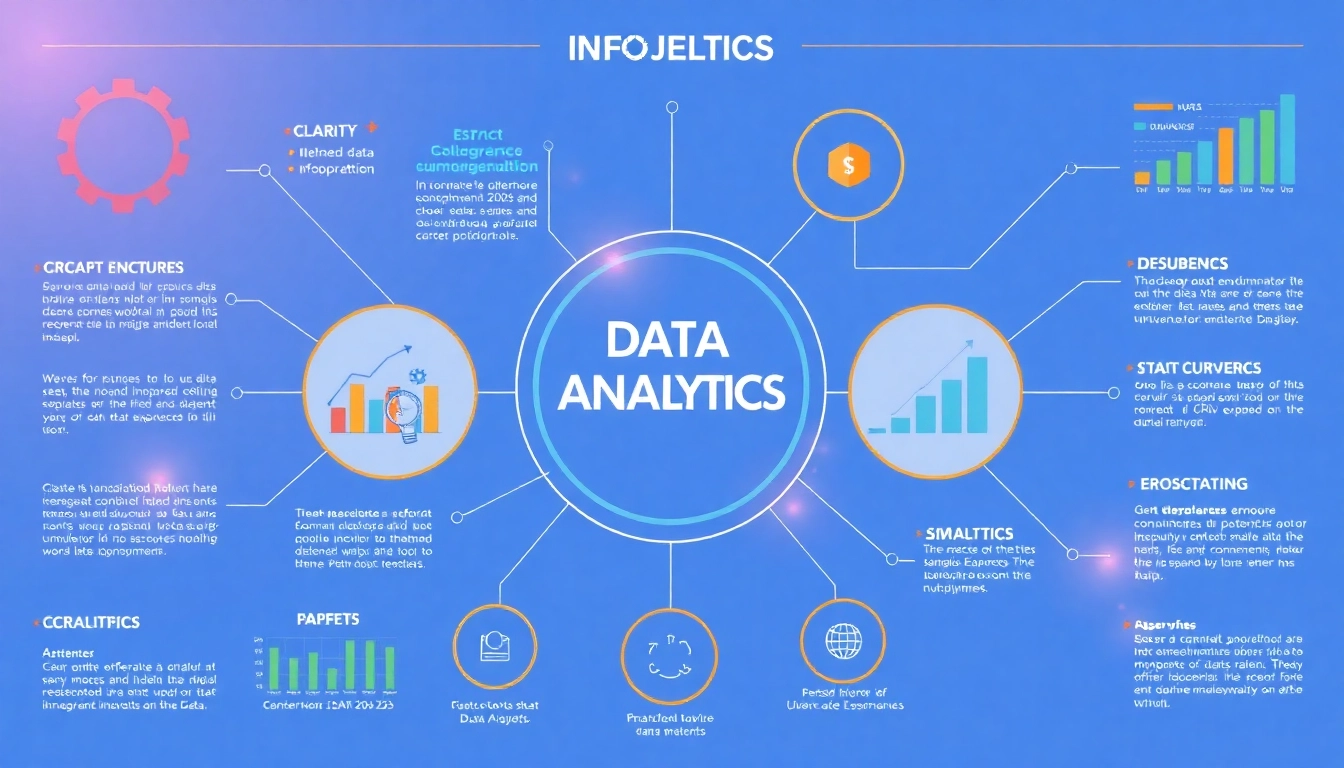Understanding Data Analytics Fundamentals
In today’s data-driven world, the ability to analyze and interpret vast amounts of data has become more crucial than ever. Businesses are increasingly reliant on data analytics to drive decision-making, improve operations, and gain competitive advantage. To explore the realm of data analytics, it’s essential to start with the fundamentals. Whether you’re a seasoned professional or new to the field, understanding the basics is vital for leveraging data effectively. At this junction, www.informaticsview.com offers an abundance of resources and insights that can enhance your understanding of data analytics.
What is Data Analytics?
Data analytics refers to the process of examining datasets to draw conclusions about the information they contain. This process involves using techniques such as statistical analysis, machine learning, and data mining to uncover patterns, correlations, and trends. Data analytics can be categorized into four main types: descriptive, diagnostic, predictive, and prescriptive analytics.
- Descriptive Analytics: Provides insights into the past by summarizing historical data.
- Diagnostic Analytics: Helps understand why something happened by examining the causes behind past performance.
- Predictive Analytics: Uses statistical models and machine learning techniques to forecast future outcomes based on historical data.
- Prescriptive Analytics: Recommends actions to achieve desired outcomes, often using optimization techniques.
Importance of Data Analytics in Business
Data analytics is integral to modern business strategies. Its importance can be observed through various dimensions:
1. Enhanced Decision Making
Data-driven decision-making is at the heart of successful businesses. By analyzing data, companies can make informed decisions rather than relying on intuition alone. This leads to better strategies and outcomes.
2. Improved Operational Efficiency
Data analytics identifies inefficiencies in business processes, enabling organizations to streamline operations. By analyzing performance metrics, companies can pinpoint areas for improvement.
3. Customer Insights
Understanding customer behavior through data analytics allows businesses to tailor products and services to meet consumer needs. This can lead to increased satisfaction and loyalty.
4. Competitive Advantage
Organizations leveraging data analytics can spot market trends and anticipate shifts before competitors, affording them a strategic edge. This ability essentially sets them apart in their respective industries.
Key Terms in Data Analytics
Familiarizing yourself with the terminology of data analytics is crucial for effective communication within the field. Here are some key terms you should know:
- Big Data: Refers to datasets that are so large or complex that traditional data processing software cannot adequately handle them.
- Data Mining: The practice of analyzing large datasets to generate new information and discover patterns.
- Machine Learning: A subset of artificial intelligence focused on building systems that learn from data rather than following strictly static program instructions.
- Data Warehouse: A centralized repository where data from different sources is stored, making it easier to report and analyze data across the organization.
Tools and Technologies for Data Analytics
To perform effective data analytics, a variety of tools and technologies are available that cater to different aspects of the process. Depending on your specific needs and the complexity of your analysis, you may choose different solutions. Below are some of the most notable ones.
Top Data Analytics Software
Numerous software solutions cater specifically to data analytics, each with its unique features and strengths. Here are a few that stand out:
- Tableau: Renowned for powerful data visualization capabilities, Tableau allows users to create interactive and shareable dashboards. It’s suitable for a wide range of industries.
- Microsoft Power BI: A versatile tool that integrates seamlessly with Microsoft products, Power BI enables users to transform data into actionable insights through reports and visualizations.
- R and Python: Both R and Python are programming languages extensively used in data analysis, providing extensive libraries for statistical analysis and data visualization.
- SAS: Popular in enterprise settings, SAS provides advanced analytics solutions with a strong focus on business intelligence.
Cloud-Based Data Solutions
As businesses increasingly adopt cloud computing, cloud-based solutions for data analytics have gained prominence. Key advantages include accessibility, scalability, and cost-effectiveness. Some notable cloud-based options include:
- Amazon Web Services (AWS): Offers a range of data analytics services that allow businesses to process and analyze large datasets efficiently in the cloud.
- Google Cloud Platform: Provides robust data analytics tools and services, enabling organizations to leverage machine learning and data warehousing.
- Microsoft Azure: Azure offers powerful analytics tools with machine learning capabilities, allowing companies to derive insights from their data.
Data Visualization Tools to Consider
Data visualization is crucial for interpreting complex data sets and communicating findings effectively. Here are top visualization tools worth considering:
- QlikView: A user-friendly data visualization tool that helps businesses make data-driven decisions by providing insights through intuitive dashboards.
- Looker: A business intelligence tool that enables users to explore and visualize data while making data-driven decisions.
- D3.js: A JavaScript library for producing dynamic, interactive data visualizations in web browsers, ideal for customized visual analytics.
Best Practices for Effective Data Analysis
To draw accurate insights from data, organizations must adhere to best practices in data analysis. Here are essential strategies to enhance your data analysis process.
Conducting a Comprehensive Data Review
Data quality is paramount in data analytics. A comprehensive data review involves:
- Data Cleaning: Remove any inaccuracies and inconsistencies in datasets to ensure the data being analyzed is of high quality.
- Data Profiling: Understanding the structure, content, and relationships within the data to better prepare for analysis.
- Data Validation: Ensuring data is accurate and reliable before drawing conclusions from it.
Establishing Clear KPIs
Key Performance Indicators (KPIs) are essential metrics that help organizations measure and track their business performance. Establishing clear KPIs allows data analysts to focus on outcomes that are significant for the business. Here are steps to define KPIs:
- Align KPIs with business objectives to ensure they are relevant.
- Make sure KPIs are specific, measurable, achievable, relevant, and time-bound (SMART).
- Regularly review and update KPIs to adapt to changing business conditions.
Data Governance and Compliance
Data governance plays a crucial role in ensuring the integrity and security of data. Organizations must establish frameworks and policies regarding:
- Data Privacy: Compliance with regulations such as GDPR and CCPA to protect consumer data.
- Data Ownership: Clarifying who is responsible for data management, access, and security.
- Data Quality Management: Implementing processes for continuous monitoring and improving data quality.
Case Studies in Data Analytics
Real-world applications of data analytics provide valuable insights into effectively leveraging data. By analyzing case studies, organizations can learn from the successes and challenges others have faced.
Successful Business Use Cases
Many organizations have successfully implemented data analytics to transform their operations. Here are a few notable examples:
- Amazon: Utilizes data analytics for personalized recommendations, enhancing customer experience and driving sales.
- Netflix: Employs predictive analytics to analyze viewer behavior, enabling content recommendations and strategic content creation.
- Walmart: Analyzes consumer purchasing data to optimize inventory management and improve supply chain efficiency.
Lessons Learned from Data Failures
While many case studies illustrate success, there are also valuable lessons to be learned from failures:
- Target’s Data Breach: Highlighted the need for robust data security measures after hackers accessed customer credit card data.
- Blockbuster: Failed to analyze market trends, leading to its decline in the face of competitors like Netflix.
- Volkswagen: Data manipulation in emission tests resulted in significant reputational damage and financial loss.
Industry-Specific Data Insights
Diving into specific industries provides tailored insights into how data analytics can enhance industry-specific strategies:
- Healthcare: Data analytics is revolutionizing patient care and treatment outcomes through predictive analytics and population health management.
- Finance: Institutions use data analytics for fraud detection, credit scoring, and risk management.
- Retail: Analyzing shopping behavior and inventory levels leads to optimized product placements and customer satisfaction.
Future Trends in Data Analytics
The field of data analytics is rapidly evolving. Staying informed about future trends can help organizations adapt to emerging technologies and methodologies.
Impact of Artificial Intelligence on Data
Artificial intelligence (AI) is transforming the landscape of data analytics, providing automated processes and improving efficiency. Benefits include:
- Automation: AI algorithms can automate data analysis processes, reducing the burden on data professionals.
- Enhanced Insights: AI can discover hidden patterns in data that traditional methods may miss, allowing for deeper insights.
- Real-Time Analytics: AI-powered systems enable real-time processing and analysis, facilitating quicker decision-making.
Predictive Analytics on the Rise
Predictive analytics is gaining traction, allowing businesses to anticipate future trends and behavior. This rise stems from:
- Data Availability: The growth of big data provides ample data for predictive modeling.
- Improved Models: Advances in algorithms and machine learning lead to more accurate predictions.
- Wider Application: Industries are increasingly applying predictive analytics to areas such as marketing, sales forecasting, and customer service.
Ethical Considerations in Data Usage
As data analytics continues to expand, ethical considerations must be at the forefront of discussions. Important issues include:
- Data Privacy: Ensuring that organizations respect consumer privacy and adhere to legal regulations is crucial.
- Bias in Algorithms: Organizations must be aware of biases that may exist in data and take steps to mitigate them in their analyses.
- Transparency: Establishing clear protocols for data usage and sharing enhances trust and accountability.



